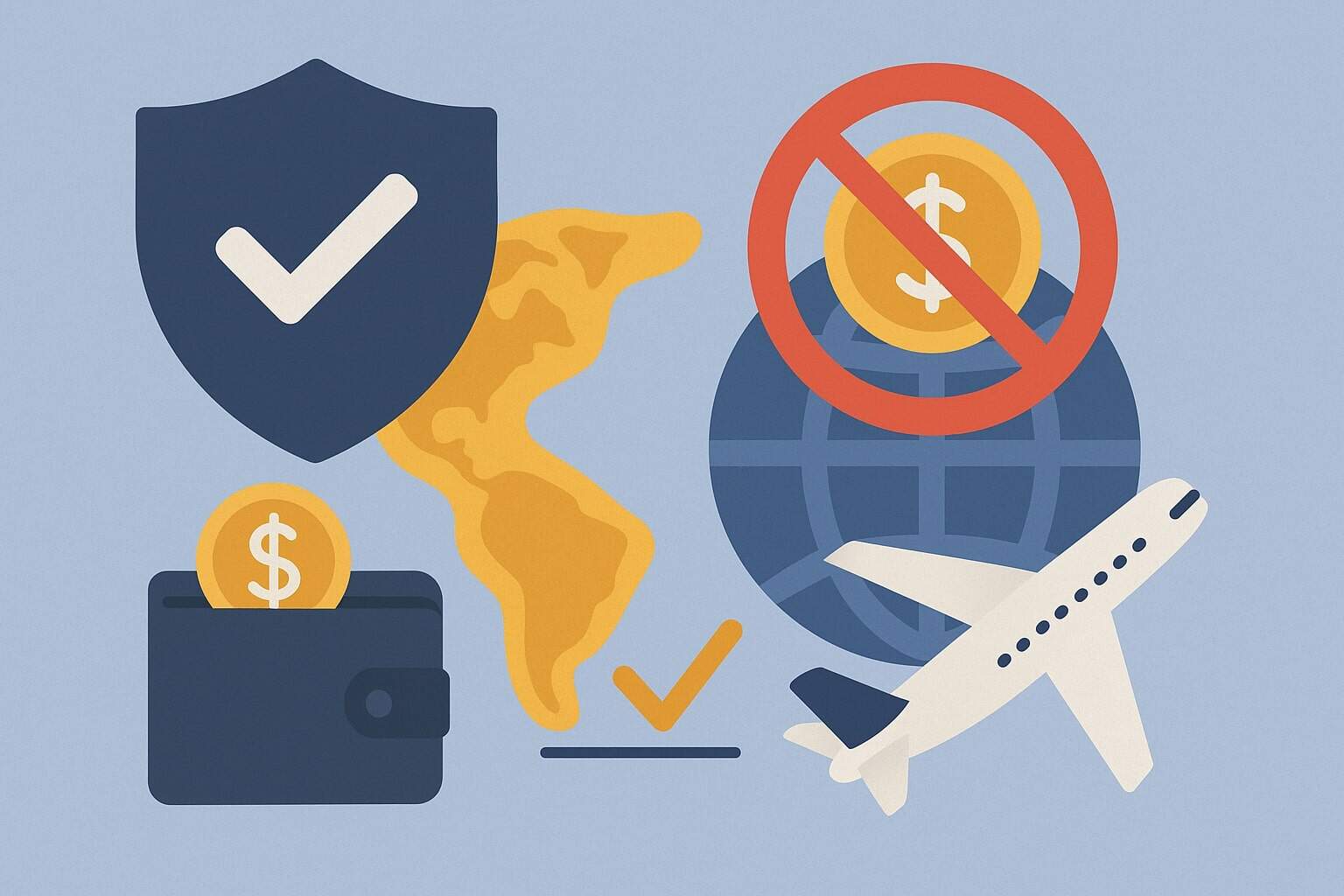
By crossborderfees September 27, 2025
Cross-border transaction fees – often called foreign transaction fees – are the extra charges levied by banks, credit card companies, and payment networks whenever you pay or send money across international borders.
In practice, almost every international purchase or money transfer involves multiple fees (interchange fees, service fees, currency conversion markups, etc.) that can add 2–5% (or more) to the cost.
For U.S. consumers and businesses, these fees are typically around 3% of the transaction amount. Over time, these “hidden” fees can really add up for frequent international travelers, expats, online shoppers, or companies making cross-border payments.
Fortunately, there are many proven ways to avoid or minimize cross-border transaction fees, from choosing the right cards and accounts to smarter payment methods. The following comprehensive guide covers the top strategies – for travel, online shopping, business payments, and everyday foreign spending – with up-to-date tips and tools for U.S. users.
Understanding Cross-Border Transaction Fees
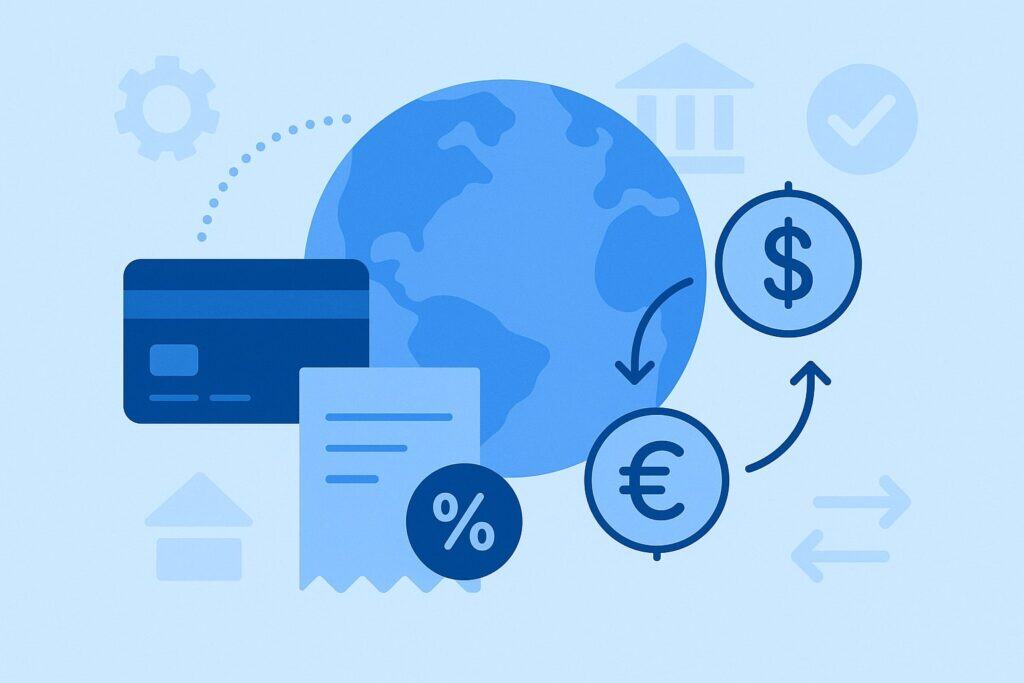
Before diving into solutions, it helps to know what you’re up against. A foreign transaction fee is usually charged by your bank or card issuer whenever you make a purchase or withdraw cash in a foreign currency or outside the U.S. (even if the merchant charges you in dollars).
In addition, many foreign transactions involve currency exchange markups: your payment network (Visa, Mastercard, etc.) will convert currencies at an exchange rate that may include a hidden spread. Combined, a typical cross-border purchase can incur:
- Foreign Transaction Fee: Often around 3% of the transaction amount, charged by the card issuer.
- Exchange-Rate Markup: A slightly worse rate than the mid-market rate (typically 1–3% above) built into the currency conversion.
- ATM Fees: When withdrawing cash abroad, you may pay both an ATM operator fee and a currency conversion fee.
- Dynamic Currency Conversion (DCC): If a merchant offers to charge you in U.S. dollars instead of local currency, that “convenience” usually comes with extremely poor exchange rates and extra fees.
For example, The Points Guy warns that choosing to pay in dollars via DCC often results in “hefty fees plus overpaying,” because the merchant or ATM applies a bad exchange rate and still tacks on your card’s foreign fee.
In short, unless explicitly waived, U.S. cards and banks typically add about 3% extra on foreign transactions. The good news is that many cards and services exist specifically to eliminate these fees. As explained below, the key is to use cards and accounts that never charge foreign-transaction fees and to pay in local currency whenever possible.
1. Use Credit Cards with No Foreign Transaction Fees
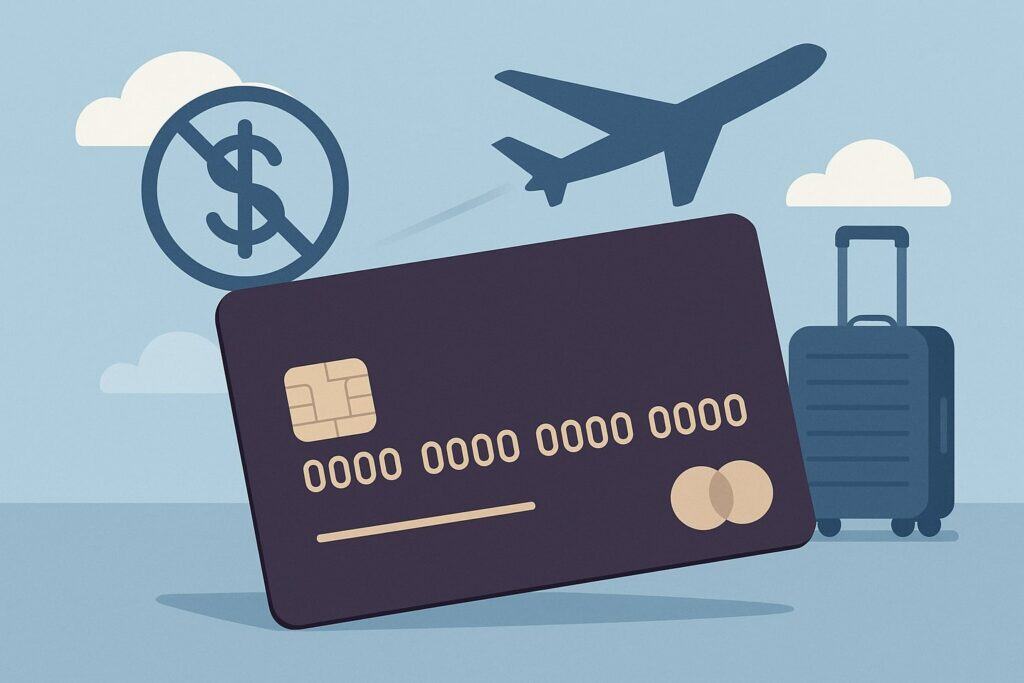
One of the simplest ways for U.S. consumers to avoid cross-border fees is by using credit cards that waive foreign transaction fees entirely. Many travel and rewards cards are designed without these fees, effectively saving you the typical ~3% surcharge on every overseas purchase.
For instance, Chase Sapphire Preferred® and Chase Sapphire Reserve® are popular travel rewards cards that explicitly charge no foreign transaction fees.
Similarly, Capital One credit cards (both travel and cash-back versions) do not add foreign fees on purchases, as NerdWallet notes that “Capital One’s U.S.-issued credit cards do not charge foreign transaction fees”.
Discover cardholders also pay no cross-border fees on purchases, although Discover’s worldwide acceptance is limited outside the U.S. (so it’s wise to carry a Visa or Mastercard as backup).
Many other cards have similar perks. For example, Wells Fargo’s co-branded Hotels.com Rewards Visa and the Bilt World Elite Mastercard® explicitly list “No foreign transaction fee” in their fee tables. Even some entry-level cards and business cards now skip the 3% fee.
When evaluating any card, check the fine print: it should clearly state “$0 foreign transaction fee.” In practice, choosing one of these cards means your international credit purchases incur only the base price (and perhaps any reward points) without the extra 2–3% sting. As NerdWallet summarizes:
“The Chase Sapphire Preferred® Card…is a best-in-class travel card…— and [it has] no foreign transaction fee.”
“The Capital One Quicksilver Cash Rewards Credit Card…can save you money… with its… lack of foreign transaction fees.”
Top tip: If you frequently travel or shop abroad, carry one or more no-fee travel cards (for example, the Chase Sapphire cards or a Capital One rewards card) to pay for all purchases.
Use a secondary backup card (Visa/Mastercard) on the rare occasions the merchant won’t take the no-fee card. This way you bypass the typical cross-border markup on credit purchases completely.
2. Leverage No-Fee Debit & Bank Accounts for Travel
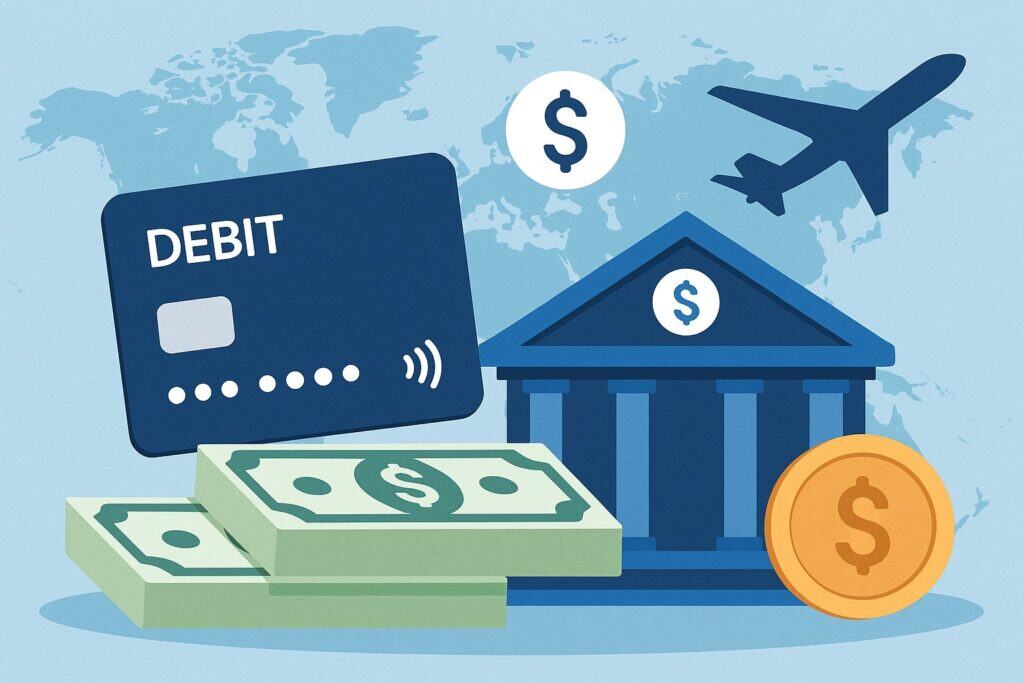
Credit cards aren’t the only way to spend abroad with zero cross-border fees. Certain checking accounts and debit cards are tailored for travelers and international use. A standout example in the U.S. is the Charles Schwab Bank Investor Checking® account.
Schwab advertises “No foreign transaction fees” on debit card purchases and “unlimited ATM fee rebates for cash withdrawals worldwide.”.
In practice, this means when you use your Schwab debit card to buy something or withdraw cash in another country, Schwab does not charge the usual 3% fee, and it will refund any ATM fees charged by foreign banks (so you effectively get fee-free cash from any ATM globally).
Opening a Schwab checking account (which has no monthly fees) gives you this travel-friendly benefit without any ongoing cost.
Other U.S. banks have similar offerings. For example, Capital One 360 checking has no foreign transaction fees on debit card purchases, and some credit unions participate in global ATM alliances to reduce costs.
Before you travel, check with your bank: many allow fee-free international ATMs or waive fees if you notify them of your travel. And if you already hold another account, consider pairing it with a travel debit card like Schwab’s.
When it comes to ATM cash abroad, use a strategic approach: take out larger sums once rather than many small withdrawals. Many banks charge a fixed fee per withdrawal, so doing one big withdrawal (and securing the cash) can be cheaper than multiple $20 withdrawals.
Also, avoid currency conversion at ATMs: if asked to convert to USD, always choose the local currency – the ATM provider’s “conversion” is usually very poor. In short, choose a travel-friendly account (like Schwab) and plan your ATM use to dodge both the bank’s foreign fee and the ATM operator’s charges.
3. Open Multi-Currency Digital Accounts and Cards (Fintech Solutions)
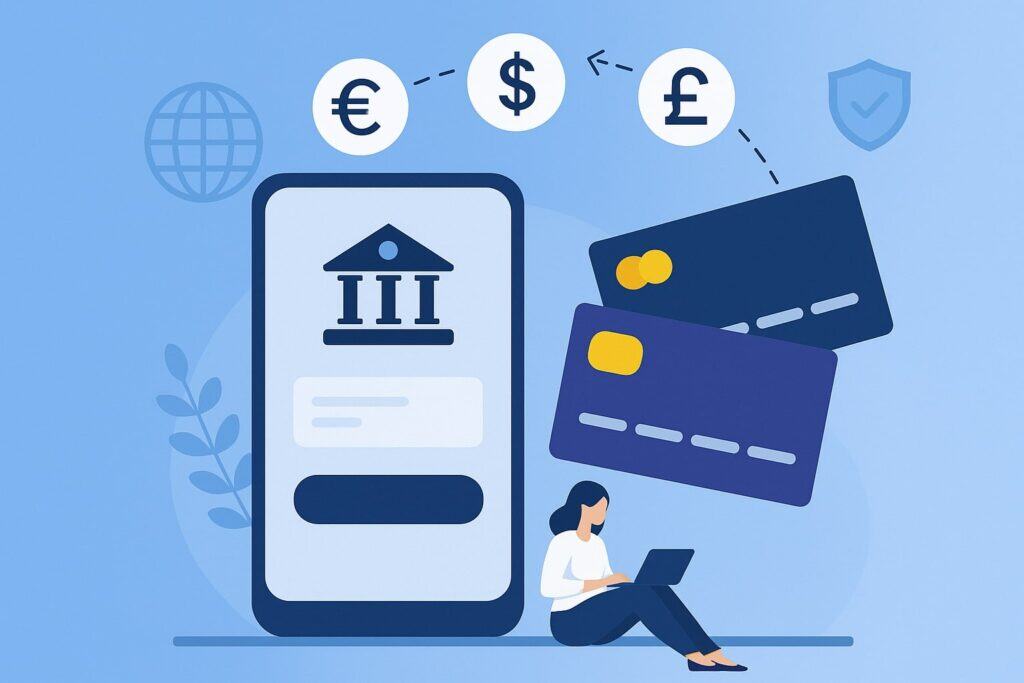
In recent years a new class of financial technology services has emerged, offering multi-currency “borderless” accounts that make cross-border spending and transfers much cheaper.
Providers like Wise (formerly TransferWise), Revolut, Payoneer, Airwallex, and others let you hold, convert, and spend multiple currencies from one account at very low cost.
For example, Wise offers an “international account” that supports 40+ currencies. You can hold dollars, euros, pounds, etc., convert between them at the true mid-market rate, and spend abroad using a Wise debit card.
According to Wise, their travel card has “no transaction fees and no markup” on the exchange rate. In practice, you load money into your Wise balance in one currency (e.g. USD) and convert to the local currency only when needed.
Since Wise uses the raw interbank rate, you avoid the typical 3% card fee and any hidden spread. Similarly, Revolut (available in the U.S.) offers multi-currency wallets and a debit card that can spend in many currencies at the interbank rate (up to monthly limits depending on plan).
Other fintechs like PayPal’s Xoom, XE Currency, or OFX specialize in low-fee international money transfers (often cheaper than banks for wires).
For example, Wise’s international account advertises support for “40 currencies” and converting at the real mid-market rate.
Using a multi-currency account effectively makes you a local: when you spend abroad, the service deducts from your balance in the same currency, so no extra cross-border or conversion fee applies.
Wise reports that holding and spending local currency “is one of the best ways to combat international transaction fees”. This approach works for travelers (spend via card or transfer to local bank) and businesses (receive and pay in multiple currencies with local account details).
In short, digital multi-currency wallets and cards let you send, receive, and spend overseas money with transparency, usually at much lower cost than a traditional bank.
4. Always Pay in Local Currency (Avoid Dynamic Currency Conversion)
A deceptively common fee trap is Dynamic Currency Conversion (DCC), where a foreign merchant or ATM offers to bill you in U.S. dollars instead of the local currency. It might sound convenient, but DCC almost always results in a worse deal.
In a DCC transaction, the merchant converts the price at a marked-up rate, then your card still applies its foreign transaction fee. The Points Guy warns that choosing DCC “might sound like a convenient way to avoid foreign transaction fees, but it’s not”. In fact, DCC rates are often 3–5% above the real rate, so you overpay even before any card fees.
Tip: Whenever using your card abroad, choose to pay in the local currency, not USD. This ensures the card network (Visa/Mastercard) handles the conversion, often at a better rate. For example, in a foreign grocery store or hotel, decline the option to pay in dollars.
Even though the amount on screen might be “$12.00 USD” instead of “€10.00”, taking the local currency option will actually cost you less. Wise explicitly advises travelers: “If it’s offered, refuse [DCC]. Pay in the local currency to save on the marked-up rates that DCC often involves”.
For ATM withdrawals, the same rule applies: if the machine asks “Withdraw in local currency or USD?”, always pick the local currency. Wise’s guide notes that the best exchange rate is always the local one. By insisting on local currency, you avoid both the merchant’s markup and the card’s extra fee.
5. Smart Use of ATMs and Cash Abroad
Getting cash in the local currency can still be useful, but you need a plan to minimize fees. As mentioned, bank ATM fees and ATM operator fees can compound. To avoid unnecessary costs:
- Use fee-free ATMs if possible: Some travel cards and banks (like Schwab) rebate all ATM fees. Others maintain global ATM alliances. Research in advance which ATMs in your destination waive fees for foreign cards.
For instance, some local banks (in Europe or Asia) partner with networks that let your U.S. card withdraw without extra charge. A quick online search can reveal “no-fee” ATM locations in major cities. - Minimize withdrawal frequency: Since each ATM visit can trigger a fixed fee, it’s often cheaper to withdraw a larger amount once than to hit the ATM multiple times.
Wise notes that many providers charge a fixed fee per withdrawal, so “withdrawing a larger sum of cash and storing it somewhere secure rather than making multiple smaller withdrawals can be cheaper.”. - Beware of secondary charges: Besides your bank’s fees, the ATM owner might add its own surcharge (which some banks like Schwab will refund, but others will not). Always read the ATM’s on-screen warnings; if it looks like an extra charge, cancel and try another machine.
- Debit vs. credit: Use your travel debit card or prepaid card for cash (never a credit card at ATMs, which is treated as a cash advance with high fees and interest). Ideally, use a bank/debit account like Schwab (which rebates fees) or a travel card like Wise (which allows some free withdrawals per month).
By combining a no-fee travel checking account with careful ATM planning, you can access cash abroad at minimal cost. For example, Schwab customers get all foreign ATM fees refunded. Wise cardholders get a couple of free withdrawals per month before a small charge. In either case, you avoid the typical 3% and the ATM operator fee.
6. Use Digital Wallets and Payment Apps Wisely
Digital wallets and payment apps can simplify overseas spending, but they aren’t always fee-free. For online purchases or small transfers, you might use services like PayPal, Apple Pay, Google Pay, or even peer-to-peer apps. These tools still rely on underlying cards or exchange services, so be aware of their fee structures.
For instance, PayPal – while convenient – charges currency conversion fees. According to a Tipalti guide, PayPal typically tacks about 3–4% on top of the wholesale exchange rate for international personal payments (about 4% for personal transfers, ~3% for business transfers).
That means if you send $100 USD via PayPal, the recipient might actually get only $96–97 worth of foreign currency after all conversion fees. Stripe (the payments processor) similarly notes that using crypto or stablecoins can “minimize cross-border exchange fees”, implying PayPal-style conversions are relatively expensive.
If you use Apple Pay or Google Pay abroad, remember these simply charge the payment to your linked card – so the card’s foreign fee (if any) still applies. In contrast, cryptocurrencies and stablecoins (like Bitcoin or USDC) operate independently of banks and can offer near-zero fees for moving money internationally (aside from blockchain gas fees).
A 2025 remittance study found that blockchain-based transfers can have fees below 1%, dramatically lower than traditional services. Some wallets (Coinbase, MetaMask, etc.) even let you pay merchants with crypto via cards, or send stablecoins peer-to-peer.
However, crypto brings complexity: you must trust exchange rates, deal with volatility, and the merchant or recipient must accept it. A growing niche is stablecoin payments for business – e.g. Stripe highlights that paying out in stablecoins “reduces cross-border fees”.
For everyday avoidance of forex fees, it’s safest to stick with known currencies via low-fee services (Wise, Revolut). But for tech-savvy users, sending a USDC or DAI transfer instead of a wire can cut costs on big payments.
In summary: digital wallets are useful, but always check if currency conversion fees apply. When they do (as with PayPal), consider alternatives (Wise transfers, crypto, multi-currency cards) which often cost much less.
7. Consolidate Payments and Consider Timing
Small fees multiply, so one strategy is to bundle your cross-border transactions whenever possible. For example, if your bank charges $5 per withdrawal, it’s cheaper to withdraw $300 once (paying $5) than $100 three times (paying $15 total).
Wise explicitly points this out for ATM withdrawals and wires. Similarly, making one large international payment can avoid multiple per-transaction fees. Some banks (like Chase) even waive wire fees on large online transfers (e.g. free for transfers over $5,000).
Also consider timing: since exchange rates fluctuate, you can watch the market for a favorable rate. And if a provider has tiered pricing (like Wise’s volume discounts), sending larger sums might reduce the percentage fee (Wise gives lower fees once monthly transfers exceed certain thresholds).
In short, be strategic: whenever possible, combine smaller transactions into one larger one, and send by the method (bank wire vs. ACH vs. P2P) with the best terms for your amount.
8. Business Solutions for International Payments
For businesses that regularly pay or receive money across borders, there are specialized tools to cut fees. Aside from the personal tactics above, companies can:
- Use multi-currency corporate accounts: Services like Wise Business or Airwallex let businesses invoice and pay in multiple currencies without hidden fees. They can hold balances in dozens of currencies and get paid locally via local bank details.
- Invoice in local currency: When possible, bill international customers in their currency. This shifts the exchange risk to them and avoids reconverting on your side.
- Partner with global merchant services: Payment platforms (Stripe, Adyen, Payoneer) offer cross-border payout services. For example, Stripe’s crypto-enabled offerings mention that using stablecoins can help “reduce cross-border fees and pay out… anywhere”. Similarly, some invoice and bill-pay platforms use PayPal, Wise, or banking rails to minimize costs.
- Negotiate wire fees: Large banks like HSBC U.S. may waive international wire fees for premium accounts. Citibank and Wells Fargo sometimes charge $0–5 for online wires (vs. $30+ for in-branch).
- Currency hedging (for very large exposure): Corporations sometimes use forward contracts to lock in exchange rates in advance, avoiding surprise costs – though this is beyond the scope of everyday cross-border fees.
The core idea for businesses is to avoid standard bank fees by using fintech payment rails and invoicing smartly. According to a Wise guide, before doing an international wire one should “consider choosing a different payment method”, such as an ACH or a peer-to-peer transfer.
In practice, combining a no-fee business card (like Capital One’s no-fee cards) with multi-currency accounts and new payment tech can drastically slash what you pay on each cross-border invoice.
9. Payment Currency and Checkout Tips
When shopping online from international retailers, always check if you can select the currency at checkout. Even e-commerce sites sometimes offer prices in USD by default. Wherever possible, opt to pay in the merchant’s local currency.
The reason, once again, is to use your card’s or service’s exchange rate (which is usually better) rather than accepting a potentially poor DCC rate.
If booking travel (hotels, flights, tours), look for prices displayed in dollars vs. local currency. Paying in USD might seem easier, but it’s often more expensive once conversions and fees are tallied. Instead, if you have a multi-currency card (like Wise or Revolut), load it with the local currency and pay from that balance.
For online shoppers using PayPal or similar, be aware that PayPal’s interface sometimes asks if you want to “Bill me in…” which is basically DCC. Always choose local currency there.
And remember: if you pay with a credit card on an international website, your card network automatically converts for you. If the site lets you pay in a foreign currency, let it do so to avoid extra markup.
10. Summary of Key Strategies
In summary, the most effective ways to avoid cross-border transaction fees include:
- No-Fee Credit Cards: Use U.S. cards with 0% foreign fees (e.g. Chase Sapphire, Capital One Venture, Discover).
- Travel-Friendly Bank Accounts: Open accounts like Schwab checking that waive foreign fees and refund ATM charges.
- Multi-Currency Fintech Accounts: Use Wise, Revolut, Payoneer, etc. to hold local currency and spend without markup.
- Pay in Local Currency: Always decline DCC; opt for the local currency to avoid hidden markups.
- Smart ATM Use: Prefer fee-free ATMs, withdraw larger amounts less often, and let your bank reimburse fees.
- Digital Transfers: For sending money abroad, use apps like Wise or stablecoins which charge well under 1% rather than expensive wire networks.
- Batch Transactions: Combine payments or withdrawals to reduce fixed fees.
- Business Tools: Use international invoicing, local accounts, and crypto/Stripe solutions to reduce payment processing costs.
By implementing a combination of these tactics, travelers and businesses in the U.S. can make international transactions “without losing out” on unnecessary fees, effectively getting the “real” exchange rate and saving potentially thousands of dollars per year.
Frequently Asked Questions
Q: What exactly are cross-border transaction fees?
A: These are additional charges that banks, credit card companies, and payment networks apply when you transact in a foreign country or currency. Typically they include a percentage of the transaction (often around 3%) plus any currency conversion markup.
For example, a $100 purchase abroad on a standard U.S. card might cost $103 after a 3% foreign transaction fee. These fees are separate from the actual exchange rate and usually show up on your statement.
Q: Why do these fees exist?
A: Banks and processors claim they cover the cost of handling international transactions and currency conversions. In reality, most card networks and issuers charge these fees as a profit source – and they often benefit if you don’t notice them.
As one guide puts it, paying in home currency “provides [the merchant] this currency exchange service” and they profit through not-so-ideal rates. By knowing about the fees, you can actively avoid them.
Q: Which credit cards have no foreign transaction fees?
A: Many U.S. travel and rewards cards fit this bill. Notable examples include the Chase Sapphire Preferred® and Chase Sapphire Reserve®, Capital One Venture and Quicksilver cards, Discover cards, and co-branded cards like the Bilt Mastercard®.
If a card listing says “No foreign transaction fee,” it’s safe for international spending. Always check current terms, but as of 2025 many major issuers offer at least one card with $0 foreign fees.
Q: How can I avoid fees at ATMs abroad?
A: Use a checking account or debit card that reimburses ATM fees. For example, Schwab Bank’s checking has no foreign fees and will refund all overseas ATM charges.
Alternatively, use travel cards that allow free withdrawals (Wise’s card offers a couple of free withdrawals each month). When you do withdraw, take out larger sums at once to minimize per-transaction fees. And always pay in local currency at ATMs to avoid a double markup.
Q: Is it better to pay in local currency or USD when abroad?
A: Almost always pay in the local currency. Choosing USD often triggers Dynamic Currency Conversion, which uses a poor exchange rate and still incurs your card’s foreign fee.
Trusted advice is to “pay in local currency” to avoid the extra costs of DCC. Your card network will then convert the charge using its own (better) rate, typically at lower cost.
Q: What about using PayPal or other apps internationally?
A: PayPal is convenient but not cheapest. It charges a currency conversion fee (about 3–4% above the wholesale rate). So if you send money via PayPal or shop via PayPal with currency exchange, expect a few percent fee.
Apps like Apple Pay or Google Pay just use your linked card (and any foreign fee it has). For sending money, consider alternatives: Wise/Xoom, Revolut, or even crypto transfers, which often have much lower fees. As noted, blockchain remittances can be under 1%.
Q: How can businesses minimize international payment fees?
A: Businesses should issue invoices in the customer’s currency or use multi-currency accounts (e.g. Wise Business, Payoneer). Payment platforms like Stripe now support paying out in stablecoins to cut fees.
You can also use international ACH or direct debit (often lower cost than wires). Negotiating wire transfers via online banking (some banks charge only $5–$15 for an online wire) and using specialized B2B services can save a bundle.
Ultimately, automating payments through services that aggregate the cheapest rails (wire, ACH, crypto) is key.
Q: Do exchange rates impact foreign transaction fees?
A: Foreign transaction fees are separate from exchange rates. Your card or bank converts currencies at whatever rate (Visa/Mastercard rate) and then applies the fee. Thus even if rates are favorable, a 3% fee is added after conversion.
Similarly, choosing DCC gives you a bad rate plus your usual fee. In short, you pay the exchange rate and a separate fee.
Q: Are cryptocurrency wallets a good way to avoid fees?
A: They can be. Sending certain cryptocurrencies (especially stablecoins like USDC) can reduce cross-border fees dramatically, often under 1%. Some peer-to-peer crypto wallets allow you to pay merchants or individuals globally without banks.
However, crypto carries other considerations (volatility, acceptance). If used, it’s best for large transfers or among parties willing to transact in crypto. For everyday foreign spending, multi-currency fintech solutions are usually easier.
Q: What’s the single best tip to cut cross-border fees?
A: Use payment methods designed for international use. That means no-foreign-fee credit/debit cards (like Capital One, Wise, Revolut) and always pay in local currency. In practice, having a smart travel card or account (for example, a Wise or Revolut card loaded with local currency) eliminates the usual fee entirely.
Combined with the strategies above (avoiding DCC, using local ATMs, leveraging ACH or crypto transfers), you can effectively avoid paying any extra fees on cross-border transactions.
Conclusion
Cross-border transaction fees are a hidden but avoidable cost of global finance. While traditional banks and cards often tack on 2–3% extra for international spending, modern alternatives let you bypass those fees.
The top solutions include using no-fee travel cards, global checking accounts, and fintech multi-currency wallets. Always pay in the local currency and leverage peer-to-peer and cryptocurrency rails when practical. For businesses, smart payment routing and invoicing in local currency can further cut costs.
By staying informed and choosing the right tools (Wise, Revolut, PayPal Xoom, Stripe stablecoins, etc.), anyone from a frequent flyer to an online shopper or expatriate can significantly reduce or eliminate cross-border transaction fees. In doing so, you’ll get more value out of every international dollar spent.